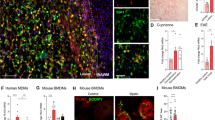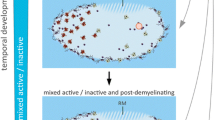Abstract
The cuprizone model is a suitable animal model of de- and remyelination secondary to toxin-induced oligodendrogliopathy. From a pharmaceutical point of view, the cuprizone model is a valuable tool to study the potency of compounds which interfere with toxin-induced oligodendrocyte cell death or boost/inhibit remyelinating pathways and processes. The aim of this study was to analyze the vulnerability of neighboring white mater tracts (i.e., the fornix and cingulum) next to the midline of the corpus callosum which is the region of interest of most studies using this model. Male mice were fed cuprizone for various time periods. Different white matter areas were analyzed for myelin (anti-PLP), microglia (anti-IBA1), and astrocyte (anti-GFAP) responses by means of immunohistochemistry. Furthermore, Luxol fast blue–periodic acid Schiff stains were performed to validate loss of myelin-reactive fibers in the different regions. Cuprizone induced profound demyelination of the midline of the corpus callosum and medial parts of the cingulum that was paralleled by a significant astrocyte and microglia response. In contrast, lateral parts of the corpus callosum and the cingulum, as well as the fornix region which is just beneath the midline of the corpus callosum appeared to be resistant to cuprizone exposure. Furthermore, resistant areas displayed reduced astrogliosis and microgliosis. This study clearly demonstrates that neighboring white matter tracts display distinct vulnerability to toxin-induced demyelination. This important finding has direct relevance for evaluation strategies in this frequently used animal model for multiple sclerosis.




Similar content being viewed by others
References
Acs P, Kipp M, Norkute A, Johann S, Clarner T, Braun A, Berente Z, Komoly S, Beyer C (2009) 17beta-estradiol and progesterone prevent cuprizone provoked demyelination of corpus callosum in male mice. Glia 57:807–814
Baertling F, Kokozidou M, Pufe T, Clarner T, Windoffer R, Wruck CJ, Brandenburg LO, Beyer C, Kipp M (2010) ADAM12 is expressed by astrocytes during experimental demyelination. Brain Res 1326:1–14
Brück W, Pförtner R, Pham T, Zhang J, Hayardeny L, Piryatinsky V, Hanisch UK, Regen T, van Rossum D, Brakelmann L, Hagemeier K, Kuhlmann T, Stadelmann C, John GR, Kramann N, Wegner C (2012) Reduced astrocytic NF-κB activation by laquinimod protects from cuprizone-induced demyelination. Acta Neuropathol 124(3):411–424
Buschmann JP, Berger K, Awad H, Clarner T, Beyer C, Kipp M (2012) Inflammatory response and chemokine expression in the white matter corpus callosum and gray matter cortex region during cuprizone-induced demyelination. J Mol Neurosci 48(1):66–76
Carlton WW (1967) Studies on the induction of hydrocephalus and spongy degeneration by cuprizone feeding and attempts to antidote the toxicity. Life Sci 6(1):11–19
Clarner T, Diederichs F, Berger K, Denecke B, Gan L, van der Valk P, Beyer C, Amor S, Kipp M (2012) Myelin debris regulates inflammatory responses in an experimental demyelination animal model and multiple sclerosis lesions. Glia 60(10):1468–1480. doi:10.1002/glia.22367
Clarner T, Parabucki A, Beyer C, Kipp M (2011) Corticosteroids impair remyelination in the corpus callosum of cuprizone-treated mice. J Neuroendocrinol 23:601–611
Garay L, Gonzalez Deniselle MC, Gierman L, Meyer M, Lima A, Roig P, De Nicola AF (2008) Steroid protection in the experimental autoimmune encephalomyelitis model of multiple sclerosis. Neuroimmunomodulation 15:76–83
Groebe A, Clarner T, Baumgartner W, Dang J, Beyer C, Kipp M (2009) Cuprizone treatment induces distinct demyelination, astrocytosis, and microglia cell invasion or proliferation in the mouse cerebellum. Cerebellum 8:163–174
Herder V, Hansmann F, Stangel M, Skripuletz T, Baumgartner W, Beineke A (2011) Lack of cuprizone-induced demyelination in the murine spinal cord despite oligodendroglial alterations substantiates the concept of site-specific susceptibilities of the central nervous system. Neuropathol Appl Neurobiol 37:676–684
Kang Z, Liu L, Spangler R, Spear C, Wang C, Gulen MF, Veenstra M, Ouyang W, Ransohoff RM, Li X (2012) IL-17-induced Act1-mediated signaling is critical for cuprizone-induced demyelination. J Neurosci 32:8284–8292
Kipp M, Norkute A, Johann S, Lorenz L, Braun A, Hieble A, Gingele S, Pott F, Richter J, Beyer C (2008) Brain-region-specific astroglial responses in vitro after LPS exposure. J Mol Neurosci 35:235–243
Kipp M, Clarner T, Dang J, Copray S, Beyer C (2009) The cuprizone animal model: new insights into an old story. Acta Neuropathol 118:723–736
Kipp M, Norkus A, Krauspe B, Clarner T, Berger K, van der Valk P, Amor S, Beyer C (2011) The hippocampal fimbria of cuprizone-treated animals as a structure for studying neuroprotection in multiple sclerosis. Inflamm Res 60:723–726
Kipp M, van der Valk P, Amor S (2012) Pathology of multiple sclerosis. CNS Neurol Disord Drug Targets 11:506–517
Lassmann H, Bruck W, Lucchinetti C (2001) Heterogeneity of multiple sclerosis pathogenesis: implications for diagnosis and therapy. Trends Mol Med 7:115–121
Linares D, Taconis M, Mana P, Correcha M, Fordham S, Staykova M, Willenborg DO (2006) Neuronal nitric oxide synthase plays a key role in CNS demyelination. J Neurosci 26:12672–12681
Lindner M, Fokuhl J, Linsmeier F, Trebst C, Stangel M (2009) Chronic toxic demyelination in the central nervous system leads to axonal damage despite remyelination. Neurosci Lett 453:120–125
Lucchinetti C, Bruck W, Parisi J, Scheithauer B, Rodriguez M, Lassmann H (2000) Heterogeneity of multiple sclerosis lesions: implications for the pathogenesis of demyelination. Ann Neurol 47:707–717
Manrique-Hoyos N, Jurgens T, Gronborg M, Kreutzfeldt M, Schedensack M, Kuhlmann T, Schrick C, Bruck W, Urlaub H, Simons M, Merkler D (2012) Late motor decline after accomplished remyelination: impact for progressive multiple sclerosis. Ann Neurol 71:227–244
Norkute A, Hieble A, Braun A, Johann S, Clarner T, Baumgartner W, Beyer C, Kipp M (2009) Cuprizone treatment induces demyelination and astrocytosis in the mouse hippocampus. J Neurosci Res 87:1343–1355
Palumbo S, Toscano CD, Parente L, Weigert R, Bosetti F (2012) The cyclooxygenase-2 pathway via the PGE(2) EP2 receptor contributes to oligodendrocytes apoptosis in cuprizone-induced demyelination. J Neurochem 121:418–427
Pott F, Gingele S, Clarner T, Dang J, Baumgartner W, Beyer C, Kipp M (2009) Cuprizone effect on myelination, astrogliosis and microglia attraction in the mouse basal ganglia. Brain Res 1305:137–149
Skripuletz T, Lindner M, Kotsiari A, Garde N, Fokuhl J, Linsmeier F, Trebst C, Stangel M (2008) Cortical demyelination is prominent in the murine cuprizone model and is strain-dependent. Am J Pathol 172:1053–1061
van der Star BJ, Vogel DV, Kipp M, Puentes F, Baker D, Amor S (2012a) In vitro and in vivo models of multiple sclerosis. CNS Neurol Disord Drug Targets
van der Star BJ, Vogel DY, Kipp M, Puentes F, Baker D, Amor S (2012b) In vitro and in vivo models of multiple sclerosis. CNS Neurol Disord Drug Targets 11:570–588
van der Valk P, De Groot CJ (2000) Staging of multiple sclerosis (MS) lesions: pathology of the time frame of MS. Neuropathol Appl Neurobiol 26:2–10
Voss EV, Skuljec J, Gudi V, Skripuletz T, Pul R, Trebst C, Stangel M (2012) Characterisation of microglia during de- and remyelination: can they create a repair promoting environment? Neurobiol Dis 45:519–528
Wood ET, Ronen I, Techawiboonwong A, Jones CK, Barker PB, Calabresi P, Harrison D, Reich DS (2012) Investigating axonal damage in multiple sclerosis by diffusion tensor spectroscopy. J Neurosci 32:6665–6669
Acknowledgments
We would like to thank H. Helten and S. Vidal de la Torre for technical assistance. This study was supported by a START grant of the Medical Faculty, RWTH Aachen (TC).
Author information
Authors and Affiliations
Corresponding author
Additional information
T. Schmidt and H. Awad contributed equally to this work.
Rights and permissions
About this article
Cite this article
Schmidt, T., Awad, H., Slowik, A. et al. Regional Heterogeneity of Cuprizone-Induced Demyelination: Topographical Aspects of the Midline of the Corpus Callosum. J Mol Neurosci 49, 80–88 (2013). https://doi.org/10.1007/s12031-012-9896-0
Received:
Accepted:
Published:
Issue Date:
DOI: https://doi.org/10.1007/s12031-012-9896-0




